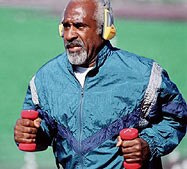hiaxis.com
Prepare to improve strength
Strength Building Workouts for Senior Citizens
Introduction
This strength-training program for Seniors was developed by experts at Tufts University and the Centers for Disease Control and Prevention (CDC).
Growing Stronger is an exercise program based upon sound scientific research involving strengthening exercises—exercises that have been shown to increase the strength of your muscles, maintain the integrity of your bones, and improve your balance, coordination, and mobility. In addition, strength training can help reduce the signs and symptoms of many chronic diseases, including arthritis.
If you're not physically active now, Growing Stronger will help you make daily activity a regular part of your life by building the essential strength that makes all movement easier and more enjoyable.
Why Strength Training?
Research has shown that strengthening exercises are both safe and effective for women and men of all ages, including those who are not in perfect health. In fact, people with health concerns—including heart disease or arthritis—often benefit the most from an exercise program that includes lifting weights a few times each week.
Strength training, particularly in conjunction with regular aerobic exercise, can also have a profound impact on a person's mental and emotional health.
Benefits of Strength Training
There are numerous benefits to strength training regularly, particularly as you grow older. It can be very powerful in reducing the signs and symptoms of numerous diseases and chronic conditions, among them:
- arthritis
- diabetes
- osteoporosis
- obesity
- back pain
- depression
Arthritis Relief
Tufts University recently completed a strength-training program with older men and women with moderate to severe knee osteoarthritis. The results of this sixteen-week program showed that strength training decreased pain by 43%, increased muscle strength and general physical performance, improved the clinical signs and symptoms of the disease, and decreased disability. The effectiveness of strength training to ease the pain of osteoarthritis was just as potent, if not more potent, as medications. Similar effects of strength training have been seen in patients with rheumatoid arthritis.
Restoration of Balance and Reduction of Falls
As people age, poor balance and flexibility contribute to falls and broken bones. These fractures can result in significant disability and, in some cases, fatal complications. Strengthening exercises, when done properly and through the full range of motion, increase a person's flexibility and balance, which decrease the likelihood and severity of falls. One study in New Zealand in women 80 years of age and older showed a 40% reduction in falls with simple strength and balance training.
Strengthening of Bone
Post-menopausal women can lose 1-2% of their bone mass annually. Results from a study conducted at Tufts University, which were published in the Journal of the American Medical Association in 1994, showed that strength training increases bone density and reduces the risk for fractures among women aged 50-70.
Proper Weight Maintenance
Strength training is crucial to weight control, because individuals who have more muscle mass have a higher metabolic rate. Muscle is active tissue that consumes calories while stored fat uses very little energy. Strength training can provide up to a 15% increase in metabolic rate, which is enormously helpful for weight loss and long-term weight control.
Improved Glucose Control
More than 14 million Americans have type II diabetes—a staggering three-hundred percent increase over the past forty years—and the numbers are steadily climbing. In addition to being at greater risk for heart and renal disease, diabetes is also the leading cause of blindness in Senior Citizens. Fortunately, studies now show that lifestyle changes such as strength training have a profound impact on helping Senior Citizens manage their diabetes. In a recent study of Hispanic men and women, 16 weeks of strength training produced dramatic improvements in glucose control that are comparable to taking diabetes medication. Additionally, the study volunteers were stronger, gained muscle, lost body fat, had less depression, and felt much more self-confident.
Healthy State of Mind
Strength training provides similar improvements in depression as anti-depressant medications. Currently, it is not known if this is because people feel better when they are stronger or if strength training produces a helpful biochemical change in the brain. It is most likely a combination of the two. When Senior Citizens participate in strength training programs, their self-confidence and self-esteem improve, which has a strong impact on their overall quality of life.
Sleep Improvement
People who exercise regularly enjoy improved sleep quality. They fall asleep more quickly, sleep more deeply, awaken less often, and sleep longer. As with depression, the sleep benefits obtained as a result of strength training are comparable to treatment with medication but without the side effects or the expense.
Healthy Heart Tissue
Strength training is important for cardiac health because heart disease risk is lower when the body is leaner. One study found that cardiac patients gained not only strength and flexibility but also aerobic capacity when they did strength training three times a week as part of their rehabilitation program. This and other studies have prompted the American Heart Association to recommend strength training as a way to reduce risk of heart disease and as a therapy for patients in cardiac rehabilitation programs.
Research and Background About Strength Training
Scientific research has shown that exercise can slow the physiological aging clock. While aerobic exercise, such as walking, jogging, or swimming, has many excellent health benefits—it maintains the heart and lungs and increases cardiovascular fitness and endurance—it does not make your muscles strong. Strength training does. Studies have shown that lifting weights two or three times a week increases strength by building muscle mass and bone density.
One 12-month study conducted on postmenopausal women at Tufts University demonstrated 1% gains in hip and spine bone density, 75% increases in strength and 13% increases in dynamic balance with just two days per week of progressive strength training. The control group had losses in bone, strength, and balance. Strength training programs can also have a profound effect on reducing risk for falls, which translates to fewer fractures.
Ready to Get Strong?
 Regular physical activity is fun and healthy, and increasingly more people are starting to become more active. Being more active is very safe for most people. However, some people should check with their doctor before they start becoming much more physically active. Experts advise that people with chronic diseases, such as a heart condition, arthritis, diabetes, or high blood pressure, should talk to their doctor about what types and amounts of physical activity are appropriate.
Regular physical activity is fun and healthy, and increasingly more people are starting to become more active. Being more active is very safe for most people. However, some people should check with their doctor before they start becoming much more physically active. Experts advise that people with chronic diseases, such as a heart condition, arthritis, diabetes, or high blood pressure, should talk to their doctor about what types and amounts of physical activity are appropriate.
If you have symptoms that could be due to a chronic disease you should have these symptoms evaluated, whether you are active or inactive. If you plan to start a new activity program, take the opportunity to get these symptoms evaluated. Symptoms of particular importance to evaluate include chest pain (especially chest pain that is brought on by exertion), loss of balance (especially loss of balance leading to a fall), dizziness, and passing out (loss of consciousness).
The physical activity readiness questionnaire (PAR-Q) will help you determine if you should check with your doctor before you start. If you are aged 69 years or older and are not used to being active, check with your doctor. Common sense is your best guide when you answer these questions. Please read the questions carefully and answer each one honestly.
Visualizing Your Goals
Believing in yourself—believing that you can leap barriers and achieve your goals—is the ticket to success. One of the most powerful tools for building self-confidence is visualization. This easy technique involves imagining the accomplishment of the changes or goals you're working to achieve. It is a process of "training" purely within the mind. By visualizing in detail your successful execution of each step in a given activity, you create, modify, or strengthen brain pathways that are important in coordinating your muscles for the visualized activity. This prepares you to perform the activity itself. The technique is useful in many areas of life—from avoiding anxiety during a stressful situation, to performing well during competition. You may find it a powerful tool in strength training.
-
 Identify the goal you want to visualize—for example, walking a golf course.
Identify the goal you want to visualize—for example, walking a golf course. - Find a comfortable place to sit and relax.
- Eliminate all distractions—turn off the phone, television, etc.
- Close your eyes and focus on feeling relaxed. Free your mind of intruding thoughts.
- Now, imagine yourself on the golf course. Create a picture in your mind of the place—the sights, sounds, and smells. Imagine a perfect day, warm and sunny, with a gentle breeze. Picture yourself with your favorite golfing friends, talking and laughing. Now visualize yourself starting on your way, passing the golf carts, and setting off to walk the whole course.
- Take a moment to feel the pleasure and excitement of achieving this goal.
- Then imagine yourself walking from hole to hole, enjoying the sunshine, the views, the fresh air, the good company and excellent play.
- Finally, visualize yourself finishing the course and feeling great, both physically and emotionally.